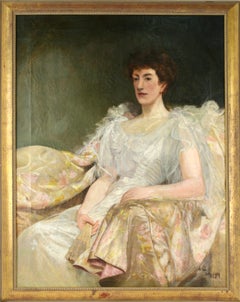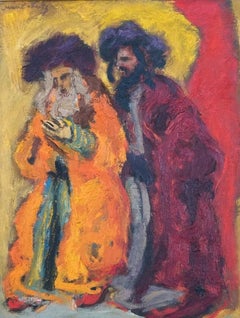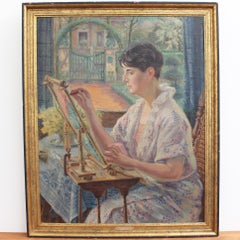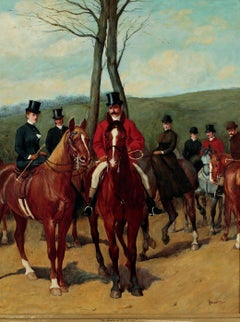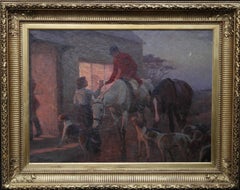John Charlton Paintings
to
1
Overall Width
to
Overall Height
to
1
1
1
1
1
1
1
1
1
1
1
1
1
1
781
717
711
695
1
1
Artist: John Charlton
Turn of Century English Portrait of Mrs. Rogerson
By John Charlton
Located in Soquel, CA
Elegant Victorian original oil portrait of Mrs. Rogerson by John Charlton
Robert Azensky Fine Art is pleased to offer this fine example of Victorian portraiture of Mrs. Frances Mary...
Category
Early 1900s Post-Impressionist John Charlton Paintings
Materials
Linen, Oil, Stretcher Bars
Related Items
Rabbis
By Mane Katz
Located in New York, NY
MANE-KATZ
RABBIS, c. 1935
Oil on canvas
18 H. x 14 W. 1/2 in. (45.5 x 35.8 cm.)
Signed
PROVENANCE
Dominion Gallery, Montreal
Christies, New York, November 04, 1982. Lot 177: $11,000
Private Collection, New Jersey, 1982-2021
Estate of the above, 2021.
Raised in an orthodox Jewish family in Russia, Mane-Katz was born in the Ukraine and became an early 20th-century artist, known especially for portraits and paintings with Jewish themes. From childhood, he had been influenced by stories of Jewish mysticism, which was reflected in his paintings.
He had a peripatetic life between Russia, France, Israel, and America. He first studied art in Kiev at the Beaux Arts Academy, and in 1913, went to Paris where he associated with Chaim Soutine and Marc Chagall and continued his art studies there at the Beaux Arts Academy.
During World War I, he tried to join the Foreign Legion but was rejected because he was too short. He went back in Russia again, this time joining the Soviet Revolution but rejected the cause because he was so horrified by Josef Stalin. He worked briefly for the Russian ballets, and in 1921, he returned to Paris where in 1927 he took French citizenship. For the next twelve years, he traveled widely, showing his art work and doing many paintings.
In 1939, as World War II was breaking out, he was drafted by the French and then was taken prisoner by the Germans. He escaped and went to the United States and remained there until 1945, exhibiting his paintings at Katia Granoff Gallery and Wildenstein Gallery. After the war, he returned to Paris where he had exhibited in the Salons. In Paris to the end of his career, he worked happily, painting hundreds of portraits of rabbis...
Category
Early 20th Century Fauvist John Charlton Paintings
Materials
Canvas, Oil
Woman by the Window with Embroidery Frame
By Franz Ludwig Kiederich
Located in London, GB
'Woman by the Window with Embroidery Frame', oil on canvas, by Franz Ludwig Kiederich (circa 1930s). A delightful depiction of a woman, comfortable...
Category
1930s Post-Impressionist John Charlton Paintings
Materials
Canvas, Oil
$1,569 Sale Price
35% Off
H 43.71 in W 36.03 in
Fragment 2 (dreamy woman portrait face painting on wood, soft Earth tones)
By Rudolf Kosow
Located in Quebec, Quebec
"Fragment" by Rudolf Kosow is a compelling painting that intricately uses the medium of wood to enhance its textural and emotional depth. The artwork features a close-up of a human f...
Category
2010s Post-Impressionist John Charlton Paintings
Materials
Canvas, Oil, Acrylic, Wood Panel
$900
H 9.85 in W 10.63 in D 0.99 in
Mother and Children Ibiza Spain oil on canvas painting
By Ignacio Gil Sala
Located in Sitges, Barcelona
Title: Genre Scene with Mother and Children
Artist: Ignacio Gil Sala (Barcelona, 1913 – 2003)
Technique: Oil on canvas
Dimensions: 46 × 38 cm (18.1 × 15 in)
Signature: Signed at the ...
Category
1980s Post-Impressionist John Charlton Paintings
Materials
Canvas, Oil
$2,830 Sale Price
20% Off
H 18.12 in W 14.97 in
Judaica Oil Painting 1945 Palestine Old Jewish Man Polish Israeli Artist
By Ozer Shabat
Located in Surfside, FL
Ozer Shabat 1978-1901
Ozer Shabbat was an Israeli painter, a resident of Haifa. Belonged to the Palestine Expressionist group of the late 1920s and early 1930s.
Shabbat was born in Wolbrom, Poland. At the end of the First World War he went to Holland for agricultural training in the framework of the HeChalutz movement, prior to his immigration to Palestine. In 1920 he immigrated to Eretz Israel and joined the Hulda group. Later he joined the Merhavia group and there he began painting. Because of his desire to study drawing, he left the group and moved to Jerusalem. In 1921, he wrote articles in the newspaper "HaSadeh" on the subject of agriculture and Dutch cheese.
Ozer Shabath won the first prize in a competition for the design of the Dutch Consulate's Garden in Jerusalem, enabling him to travel to Paris in 1923 to study painting. Until 1925 he studied painting at the Grande Chaumiere Academy in Paris. This year he returned to Eretz Israel and settled in Haifa, where he lived until his death.
In 1928 he participated for the first time in an exhibition of Eretz Israel artists at the Tower of David. Since then he has participated in all the general exhibitions of Israeli artists. In 1934, together with painters Menachem Shemi, Avraham Mohar, Zvi Meirovitch and others, he founded the Haifa Artists' Group. In 1935-36 he toured Europe and visited Italy, France and England. During his visit, he maintained contacts with artists from the Jewish school of Paris.
He has exhibited in several solo exhibitions, represented Israel in exhibitions in Europe and participated in international exhibitions in New York, Johannesburg and Zurich. In 1958 he represented Israel in the Venice Biennale. In 1960, Shabat, together with Elchanan Halpern he represented the Israeli Painters Association at the International Congress of Plastic Arts held in Vienna, Austria . In the 40s and 50s he focused on landscape pictures. However, despite the focus on the Israeli landscape, the approach is universal in the framework of the post-Impressionist painting school. In the 1960s, his approach changed and he turned more to abstraction. The abstract direction gradually evolved. The point of departure of the abstract approach is the architectural landscape, but this view loses its real character and becomes only imaginary: the buildings lose their real character and turn into exclusive geometric areas that are usually set against a dark background. Over time, architecture captured the lion's share of his paintings. Cities like Safed, Jaffa and Jerusalem are the subject of many pictures.
He taught painting and art at the schools of the kibbutzim in Ramat Yochanan and Kfar Yehoshua, in high schools in Haifa and in the IDF and Gordon seminars.
His paintings were purchased and are in the permanent collection of the Bezalel National Museum (now the Israel Museum), Haifa Museum of Art, Haifa Maritime Museum, Acre Municipal Museum.
Select Solo exhibitions
1936 - Nadler Gallery, Haifa.
1943 - The Tel Aviv Museum of Art.
1952 - Artists House, Haifa.
1953 - Bezalel House, Jerusalem.
1955 - Gallery in Geneva, Switzerland.
1955 - The Writers' Club, Haifa.
1959 - Artists House, Haifa.
1960 - Museum of Modern Art, Haifa.
1962 - Museum of Modern Art, Haifa.
1963 - Gallery 220, Tel Aviv.
1968 - The Municipal Museum of Beit Emanuel, Ramat Gan.
1979 - Memorial exhibition marking the first anniversary...
Category
1940s Post-Impressionist John Charlton Paintings
Materials
Canvas, Oil
$2,200
H 22.5 in W 19 in
woman in white oil on canvas painting portrait
By Ignasi Mundó
Located in Sitges, Barcelona
Ignasi Mundó Marcet (1918-2012) - woman in white - Oil on canvas
Canvas measures 73x60 cm.
Frame size 76x63 cm.
MUNDO Ignasi
Ignasi Mundó trained at the School of La Lonja, with Joa...
Category
1940s Fauvist John Charlton Paintings
Materials
Canvas, Oil
$826 Sale Price
41% Off
H 28.75 in W 23.63 in
gypsy woman oil on canvas painting
By Josep Serrasanta
Located in Sitges, Barcelona
Josep Serrasanta (1916-1998) - Gypsy woman - Oil on canvas
Oil measures 65x50 cm.
Frame measures 88x73 cm.
Josep Serrasanta was born in Buenos Aires (Argentina) in 1916 - 1998 Valdo...
Category
1980s Post-Impressionist John Charlton Paintings
Materials
Canvas, Oil
Fauve Portrait of Three Women in Blue Holding Red Abanicos
By Bernie Fuchs
Located in Miami, FL
Bernie Fuchs's painting "Fauve Portrait of Two Women in Blue with Red Abanicos" captures a festive scene of three Spanish women in traditional dress at...
Category
1960s Fauvist John Charlton Paintings
Materials
Canvas, Oil
$8,000 Sale Price
20% Off
H 22 in W 12 in D 2 in
Woman by the sea oil on canvas painting mediterranean
Located in Sitges, Barcelona
Frame size 69x60 cm.
Category
21st Century and Contemporary Post-Impressionist John Charlton Paintings
Materials
Canvas, Oil
$825 Sale Price
53% Off
H 21.66 in W 18.12 in
Mid Century French Fauvist Portrait, Oil on Canvas, Circle of Kees van Dongen
Located in Cotignac, FR
Large Mid Century French Fauvist oil on canvas portrait by Bourgault. The painting is signed bottom left and signed, located and titled to the top back stretcher. The location is mar...
Category
Mid-20th Century Fauvist John Charlton Paintings
Materials
Canvas, Oil
$4,127
H 36.23 in W 28.75 in D 0.79 in
"Girl Sewing" Post-Impressionist Portrait of Seated Girl Oil Painting on Canvas
By Jacques Zucker
Located in New York, NY
An outstanding oil painting depicting a portrait of a seated girl sewing. The subtle tones and bright pops of colors are what makes this piece so attractiv...
Category
20th Century Post-Impressionist John Charlton Paintings
Materials
Oil, Canvas
$3,500
H 20.5 in W 17.5 in D 2 in
Large Judaica Jerusalem Oil Painting Israeli Jewish Rabbi Artist Tzvi Raphaely
By Zvi Raphaeli
Located in Surfside, FL
Rabbi Portrait, Oil Painting
Framed: 37.5 x 26. Canvas: 31.5 X 20
Bears original label verso from Safrai Gallery
Lovely Israeli Chassidic Rabbi portrait oil painting, vibrant colorful painting. Hand signed in Hebrew and English. Done in a style similar and influenced by Marc Chagall.
Svi Raphaely (also known as Tzvi Raphaeli...
Category
20th Century Post-Impressionist John Charlton Paintings
Materials
Canvas, Oil
Previously Available Items
The Master of the Hounds
By John Charlton
Located in Sheffield, MA
John Charlton
English, 1849- 1917
The Master of the Hounds
Oil on canvas
36 by 28 in. W/frame 47 ½ by 39 ½ in.
Signed lower right
Early life:
Born to Samuel Charlton and his wife Mary Ann (née Pickering) Charlton on 28 June 1849, in Bamburgh, Northumberland, he received his first lessons in drawing from his father when he was only three or four years old, and within a few years was drawing horses with some skill. Due to his family’s financial misfortunes, he had to attend Dr. Sharp’s charity school held in Bamburgh’s great castle, and a few years later, was forced to quit and find employment. A job in the Newcastle bookshop of Mr. Robinson, a keen collector of the work of Thomas Berwick, “the father of Wood engraving,” gave him an appreciation of graphic art. It was here that the budding artist began to imitate the master’s work, much to the delight of two of Berwick’s aging sisters. Later he spent seven monotonous years employed in the office of Sir Isaac Bell’s ironworks, but seeing the young man’s skill at draughtsmanship, his employers regularly granted him one day a week in which to practice his art. Mr. Joseph Crawhill suggested that he attend evening classes at the Newcastle School of Arts under William Bell Scott. During this time he began to develop quite a reputation on Tyneside as a painter of horses and dogs, and he received some commissions to portray family pets.
He debuted at the Royal Academy in 1870, and his first painting with a military theme, Exercising artillery horses on a frosty morning, appeared three years later. Realising that his best prospects for advancement lay in the London art world, he ventured south in 1874 and took classes at the South Kensington Museum, now the Victoria and Albert Museum, under J. D. Watson.While he settled in the capital, he never forgot his northern roots, maintaining a house at 24 Windsor Terrace, Newcastle, and at one time lived at Cullercoats, while his final years were spent at Lanercost in Cumbria.
The late 1870s and 1880s were a very busy time for British and colonial forces as they tried to consolidate colonial hold over possessions in northern and southern Africa. Many of the illustrations appearing in The Graphic depicting these events came from the hand of Charlton, especially during the Egyptian campaign of 1882, when he had to draw-up many of the eye-witness sketches posted to the paper by its ‘special artists’ as well as soldiers. It was also during 1882 that he married Kate, daughter of Thomas Vaughan, J.P. of Ugthorp Lodge, Cleveland.
Military Paintings:
Exposed to the wealth of military illustration he decided to try his hand at creating a large painting on canvas using a war theme, and in 1883 exhibited British artillery entering the enemy’s lines at Tel-el-Kebir, 13 September 1882. It was well received, one writer asking, "who can look unmoved upon his vigorous and vividly realistic rendering." Spurred on by the success of this work which "opened up for him a field in which he could find freer scope for his artistic sense of vivid movement and powerful action in both horse and figure-painting, and exercise for his keen imagination," he chose another military scene for his 1887 academy piece. Based on a sketch by Surgeon N. C. Ross of the Royal Marines, Bad news from the front represented the first news of the disaster to General McNeill’s column during the Suakim campaign of 1885: "A number of horses of the Bengal Lancers having broken through the zeriba [thorn-bush stockade] in confusion, galloped back to headquarters, and created much excitement and alarm, it being conjectured that some terrible disaster had befalled the advance column." He returned to the Sudan campaign for his 1893 piece, Placing the Guns, the same year his wife died leaving him to look after their two young sons.
For his next military subject, Charlton turned once again to men and horses in battle with a theme from the Zulu War: After the charge: 17th Lancers, Ulundi, July 4, 1879, which was shown at Burlington House in 1888. The regiment was to figure again later in the artist’s work. Some years previously, he had painted a portrait of Lord Tredegar who had led the lancers out of the fateful charge at Balaklava on 25 October 1854, and no doubt inspired by hearing the nobleman’s account during the sittings as well as reading Kinglake’s history of the Crimean War, Charlton exhibited several paintings of the charge. An Incident in the charge of the Light Brigade...
Category
1880s Victorian John Charlton Paintings
Materials
Oil
The End of day - British 1900's oil painting hunting scene inn hounds horses
By John Charlton
Located in Hagley, England
A large fine oil on canvas which dates to circa 1900 by noted British artist John Charlton. This is one of the best large romantic works that I have seen by this artist. It depicts The End of the Day for a huntsman and his hounds as they stop for a drink under the glowing evening of a cresupular moon. A stunning painting. Signed lower left.
Provenance. Christies London
Framed in a fine gallery frame 41 by 34 inches.
John Charlton was a very successful British artist known for his powerful military scenes, detailed and accurate animal and figure paintings, and vivid landscapes. He debuted at the Royal Academy in 1870 and exhibited there until 1904, contributing 53 works.
He was born in a county in North East England and received his first drawing lessons from his father. Due to his family’s financial misfortunes, Charlton was enrolled in Dr. Sharp’s charity school, but a short time later was forced to quit and find employment. His first job was at a bookstore, which gave the promising artist a chance to copy the master’s work. Years later, while working as a draughtsman, his employers noticed his extraordinary talent and regularly granted him time to practice his art. At the suggestion of Mr. Joseph Crawhill, a notable British illustrator, Charlton began to attend evening classes at the Newcastle School of Arts under William Bell Scott. It was during this time that Charlton developed a reputation as a skilled painter of horses and dogs, and began receiving commissions to portray family pets.
In 1874, realizing that his best chance for advancement lay in the London art world, he ventured south and took classes at the South Kensington Museum, now the Victoria and Albert Museum. To earn a living Charlton became an illustrator for The Graphic, and his sketches of the Egyptian Campaign of 1882 were often reproduced in the popular weekly illustrated British newspaper. Experiencing the wealth of military illustration, he decided to try his hand at creating a large war-themed painting, and in 1883 exhibited British artillery entering the enemy’s lines at Tel-el-Kebir, 13 September 1882. The critics praised the canvas calling it a “vigorous and vividly realistic rendering.” Spurred on by the success, he chose another military scene for his 1887 academy piece. Based on a sketch by a Royal Navy surgeon, Charlton painted Bad News from the Front, a scene from the Suakim campaign of 1885. For his 1893 piece, Placing the Guns, he returned to the Sudan campaign. His next military subject was from the Zulu War, After the Charge: 17th Lancers, Ulundi, 4 July 1879, which was shown at Burlington House in 1888. Charlton exhibited several paintings from the Crimean War, including An Incident in The Charge of the Light Brigade...
Category
19th Century Realist John Charlton Paintings
Materials
Oil
Return of the Guns Victorian Shooting Party signed oil painting
By John Charlton
Located in Cirencester, Gloucestershire
Very fine, large scale original Victorian oil painting on canvas, depicting a traditional shooting party, "The Return of the Guns". The painting is ...
Category
Late 19th Century Victorian John Charlton Paintings
Materials
Oil
H 30 in W 44 in D 1 in
John Charlton paintings for sale on 1stDibs.
Find a wide variety of authentic John Charlton paintings available for sale on 1stDibs. You can also browse by medium to find art by John Charlton in oil paint, paint and more. Not every interior allows for large John Charlton paintings, so small editions measuring 44 inches across are available. Customers who are interested in this artist might also find the work of Alfred de Breanski Sr., John Emms, and Charles Jones (b.1836). John Charlton paintings prices can differ depending upon medium, time period and other attributes. On 1stDibs, the price for these items starts at $15,484 and tops out at $15,484, while the average work can sell for $15,484.
